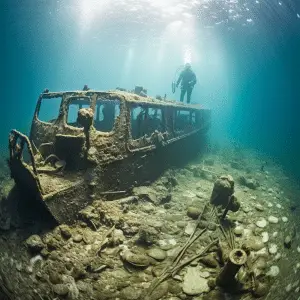The Great Lakes, a vast system of freshwater lakes in North America,
hold a fascinating secret beneath their depths: a treasure trove of shipwrecks.
These underwater time capsules offer a glimpse into the rich maritime history of the region and provide an unparalleled diving experience.
In this article, we will explore the allure and adventure of diving into the shipwrecks of the Great Lakes,
uncovering hidden treasures preserved beneath the surface.

The Great Lakes Shipwreck Coast
The Great Lakes are home to thousands of shipwrecks, earning the region the title of the “Shipwreck Coast.”
Lake Superior, Lake Michigan, Lake Huron, Lake Erie,
and Lake Ontario have witnessed countless maritime disasters throughout history.
The combination of treacherous weather conditions,
rocky shorelines, and navigational challenges has claimed numerous vessels,
making the Great Lakes a captivating destination for wreck diving enthusiasts.
Diving Highlights
Historic Shipwrecks
The shipwrecks of the Great Lakes span a range of historical periods, offering divers a unique opportunity to explore the remnants of vessels from different eras.
From wooden schooners to iron ore freighters, each shipwreck tells a story of the past.
Divers can marvel at the craftsmanship of bygone eras and imagine the lives of those who sailed these waters.
Well-Preserved Artifacts
The cold, freshwater environment of the Great Lakes helps preserve the shipwrecks and their accompanying artifacts.
Divers can encounter a variety of well-preserved relics,
including anchors, cannons, cargo, and even personal belongings.
These artifacts provide a tangible connection to the past and offer a glimpse into the daily lives of the sailors who once navigated these waters.
Underwater Photography Opportunities
The shipwrecks of the Great Lakes create a stunning backdrop for underwater photography.
The clear waters, combined with the dramatic structures of the wreckages, allow divers to capture breathtaking images.
Photographers can document the intricate details of the shipwrecks, play with light and shadows, and showcase the unique beauty of these submerged time capsules.
Marine Life Encounters
The shipwrecks of the Great Lakes serve as artificial reefs, attracting a diverse array of marine life.
Divers can encounter schools of fish, such as lake trout, whitefish,
and bass, swimming among the wreckages.
The structures of the shipwrecks also provide shelter for a variety of invertebrates,
including colorful sponges and corals.
Exploring these underwater habitats offers a chance to witness the interconnectedness of marine ecosystems.
Notable Shipwrecks
The Great Lakes are home to numerous notable shipwrecks,
each with its own unique characteristics and historical significance.
Some popular dive sites include:
The SS Edmund Fitzgerald (Lake Superior)
The SS Edmund Fitzgerald is perhaps the most famous shipwreck in the Great Lakes.
Sunk in 1975, it remains an iconic symbol of the region’s maritime history.
Diving into the wreckage, located in Lake Superior,
offers a solemn and humbling experience.
The sheer size and scale of the ship are awe-inspiring, and paying homage to the crew members who lost their lives is a poignant reminder of the power and unpredictability of the Great Lakes.
The Anthony Wayne (Lake Michigan)
The Anthony Wayne, a wooden steamship, sank in 1850 and now rests on the bottom of Lake Michigan.
Diving into this shipwreck allows divers to witness the preserved remains of a vessel from the mid-19th century.
The ship’s paddlewheel and other artifacts provide a glimpse into the era of steam-powered transportation on the Great Lakes.
The Regina (Lake Huron)
The Regina, a steel freighter, met its demise in 1913 during the Great Storm of 1913, one of the most devastating weather events in the region’s history.
Diving the wreck of the Regina, located in Lake Huron, offers a chance to explore a well-preserved shipwreck and pay tribute to the lives lost during the storm.
The wreckage, covered in marine life, creates a hauntingly beautiful underwater scene.
The Carl D. Bradley (Lake Michigan)
The Carl D. Bradley, a 639-foot limestone carrier, sank in Lake Michigan in 1958.
Diving into the wreckage allows divers to witness the remains of a vessel that was once among the largest on the Great Lakes.
The size and scale of the ship are impressive, and exploring its structure provides a sense of the immense power and forces at play on the Great Lakes.
Diving Safety and Considerations
Diving the shipwrecks of the Great Lakes requires careful planning and consideration for safety.
The cold water temperatures, strong currents, and limited visibility can present challenges to divers.
It is crucial to have proper training, experience, and equipment suitable for cold-water diving.
Diving with a knowledgeable dive operator who is familiar with the area and the specific wreck sites is highly recommended to ensure a safe and enjoyable experience.
Preservation and Conservation
Preserving and protecting the shipwrecks of the Great Lakes is essential for future generations to explore and appreciate these historical treasures.
Divers should practice responsible diving techniques, such as not disturbing or removing artifacts, respecting the wreck sites,
and following established guidelines for visiting these fragile underwater environments.
Additionally, ongoing efforts by government agencies,
conservation organizations, and volunteers aim to survey and document the shipwrecks,
conduct research, and promote the preservation of the Great Lakes maritime heritage.

Conclusion
Diving the shipwrecks of the Great Lakes is a captivating journey into the region’s maritime history and a thrilling underwater adventure.
Exploring these submerged time capsules allows divers to connect with the past, witness the beauty of these underwater habitats,
and encounter marine life that has made these wreckages they’re home.
With proper training, preparation, and a sense of respect for these historical treasures,
divers can uncover hidden treasures and create memories that will last a lifetime.
So, grab your diving gear, dive into the depths of the Great Lakes,
and embark on an extraordinary exploration of submerged history and marine life.
Happy diving!
